Matthew D. Kamm
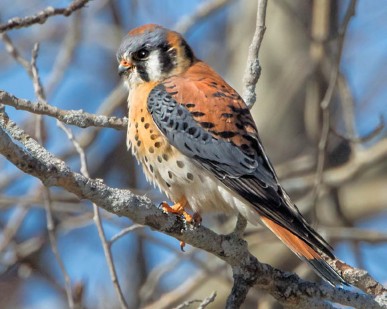
American Kestrel. All photographs by Sandy Selesky.
Whenever I drive by an open grassy field with utility wires paralleling the road, I always scan the lines for the silhouette of a hunting kestrel. Too often, though, my glances reveal no more than a flock of idling starlings or a pair of Mourning Doves. By now, it really is not news to most birders and ornithologists that American Kestrels are rapidly declining. According to the USGS Breeding Bird Survey, kestrel numbers are declining an average of 1.6% per year, with annual declines exceeding five or six percent in some regions. The question on many people’s minds is “how did this happen?”
Rarity was not always the rule for kestrels. As with many species, consulting the historical record for information about kestrels is complicated by the multiple common names that were used for this species. W.L. McAtee’s collected Folk Names of New England Birds, which appeared originally in the Massachusetts Audubon Society Bulletin in the mid-1950s, refers to this bird as “Sparrow Hawk.” The kestrel was also, confusingly, sometimes called “Pigeon Hawk,” a name more commonly assigned to the Merlin (Falco columbarius) due to its size. “Killy Hawk,” a name derived from the kestrel’s shrill repeated “killy-killy-killy” call, is mercifully unambiguous.
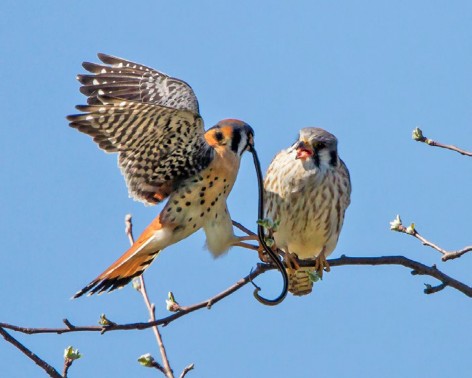
American Kestrel male brings snake to female.
Nonetheless, the kestrel is generally identifiable in the historical record, especially when the work includes an illustration to accompany natural history information about the bird. Such is the case with Mark Catesby’s The Natural History of Carolina, Florida, and the Bahama Islands, one of the best natural history resources composed in the Americas during the early eighteenth century. Catesby referred to the species as “The Little Hawk,” and though he does not comment on their abundance, he does say that they could be found year-round throughout Virginia and Carolina and that they ate a wide variety of large insects and small vertebrates. By the mid-nineteenth century, John James Audubon’s Birds of America had become the definitive resource on avian natural history in the United States. Of the bird he called the American Sparrow Hawk, Audubon said, “We have few more beautiful Hawks in the United States than this active little species, and I am sure, none half so abundant.” During the winter in the southern states, when migrant kestrels from farther north join the resident southeastern subspecies (Falco sparverius paulus), Audubon reported that he saw kestrels in “about every old field, orchard, barn-yard, or kitchen-garden...”
In Massachusetts, the historical record is sparse. In precolonial times, most of Massachusetts was forested. Native people managed the land through regular burning, and lightning strikes also caused fires throughout the state, thereby creating areas of open habitat suitable for kestrels. In their first written reports, Europeans noted kestrels in some natural heathlands across the state. The eminent Edward Howe Forbush wrote briefly of the falcons in his 1913 Useful Birds and Their Protection. He said that none of them (kestrel, Merlin, and Peregrine Falcon) were “very common” in Massachusetts, but then stated that the Merlin and peregrine were “uncommon or rare,” implying that kestrels were somewhere between “uncommon” and “very common.” By 1927, in his Birds of Massachusetts and Other New England States, Forbush wrote that kestrels were not only becoming more common in eastern Massachusetts, but also nesting in urban areas in close proximity to humans. Even so, he acknowledged that the species remained a bird of the farmlands first and foremost, and therein lies the likely crux of this bird’s difficulty: loss of habitat.
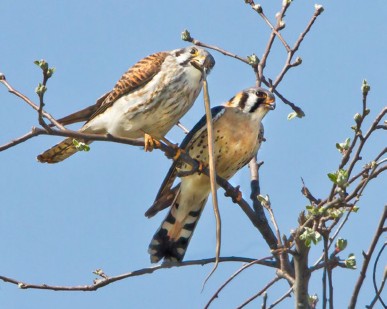
American Kestrel pair. Female with snake.
After being driven nearly to extinction by organochlorine pesticides, other raptors including the Bald Eagle, Peregrine Falcon, and Osprey have staged remarkable recoveries. Kestrels, however, have continued on a steady pattern of decline throughout their range and Massachusetts has been no exception. The Breeding Bird Atlas 2 reported kestrels in fewer than half the number of blocks they occupied during the first Atlas in the late 1970s (Kamm et al. 2013). These rapid losses have prompted focused action from many conservation organizations to better understand and address this decline (Smallwood et al. 2009). Numerous hypotheses have been proposed for kestrel decline, including toxic chemicals (Sullivan et al. 2013), disease (Dubé et al. 2010), predation by larger raptors (Farmer et al. 2008), competition for nest cavities with invasive species (Koenig 2003), and loss of habitat (Farmer et al. 2008).
These drivers are often obscure or difficult to assess in wild populations. The endocrine disrupting effects of polybrominated diphenyl ether (PBDE) flame retardants in kestrels have been widely studied and well-documented but will not be the focus of this piece; for a recent paper on the topic, see Fernie et al. (2015). West Nile Virus was responsible for considerable bird mortality in corvids and raptors during the earliest years of the 21st century (CDC 2015), but the patterns in kestrel decline have occurred on a longer time scale, often predating the introduction of West Nile Virus. Wild populations of kestrels in Quebec and Pennsylvania also showed widespread exposure to the virus, as determined by the presence of antibodies in the blood, but the exposed kestrels bred successfully and did not exhibit apparent ill effects (Medica et al. 2007, Smallwood et al. 2009). Though it is likely that the introduction of West Nile Virus to the American Kestrel population did not do the bird any favors, it seems that “flock immunity” has set in, and the virus is likely not a significant contributor to declining kestrel numbers.
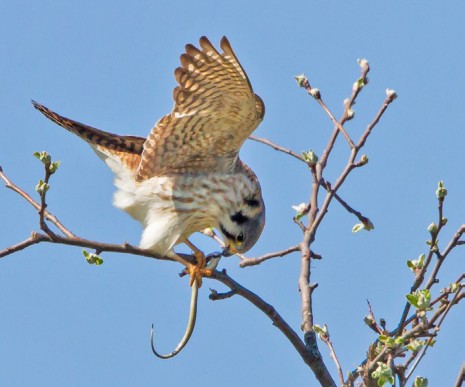
American Kestrel female eats snake.
The predation on kestrels by Cooper’s Hawks remains mysterious. That Cooper’s Hawks occasionally prey on kestrels is not in question; see Smallwood and Bird (2002) for a summary of historic accounts of this behavior. However, the degree to which this predation represents a threat to kestrel populations at large is uncertain. On one hand, Cooper’s Hawks are an expanding species in many parts of their range. These forest hawks are taking full advantage of the reforestation of former agricultural areas such as has occurred in Massachusetts. In addition, Cooper’s Hawks were once killed with abandon as a threat to domestic poultry (Forbush 1927), but they are now observed and appreciated. In Massachusetts, breeding Cooper’s Hawks were recorded in 531—about half—of the blocks surveyed during the second Breeding Bird Atlas, compared to only 15 blocks in the first Atlas (Kamm et al. 2013). The resurgence of the Cooper’s Hawk coincides with the decline of the American Kestrel, but is the relationship causal? A broad analysis of abundances using Breeding Bird Survey data did not detect a clear connection (Smallwood et al. 2009), but the question is not settled, especially considering the likely complex relationship between Cooper’s Hawks, American Kestrels, and habitat structure. As forest birds that often patrol woodland edges, Cooper’s Hawks would encounter kestrels most frequently on the ecotone between forests and open fields. It is likely that in parts of the kestrel’s range where large areas of open habitat are not juxtaposed with forest, predation from accipiters is less of an issue.
Loss of habitat is a significant factor limiting the populations of many bird species, and grassland bird species in particular are feeling the squeeze. More than 50% of native grassland and savanna habitat in the United States has already been lost to development and intensive agriculture. This habitat type is one of the most imperiled in the world today in terms of the rate at which it is being converted to other land use types, such as forest or developed land (White et al. 2000, Hoekstra et al. 2004). Kestrels are looking for an even more specific habitat than most grassland birds: not only do they need open space to forage, they need an available cavity such as an old woodpecker hole in which to nest. Trees with pre-existing cavities large enough to host a kestrel nest that are also adjacent to open hunting territory are not necessarily easy to find. Fortunately, kestrels take readily to artificial nest boxes, and many programs around the country have been started to bolster local kestrel numbers (Smallwood et al. 2009). Kestrels have taken to these boxes in many cases, yet occupancy rates are often lower than expected or decline over several years. While boxes in apparently suitable habitat go unused, increasing attention is being paid to kestrels in urban areas, just as Forbush reported in the 1920s. During the course of my field work, I have found kestrels breeding in residential areas of Cambridge and Somerville, and in unlikely spots such as storage warehouses adjacent to power corridors. Clearly, the habitat requirements of kestrels are not as simple as “open grasslands,” and a more nuanced analysis is called for.
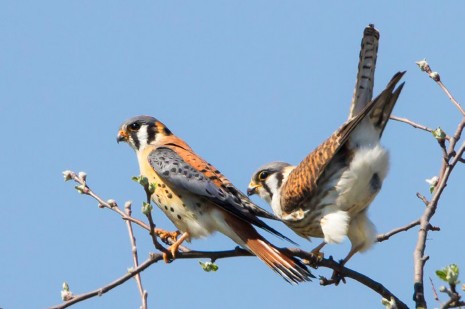
American Kestrels after mating.
Fortunately, there are plenty of data available from the large number of nest boxes that are being put up for kestrels. A large network of boxes has been erected and maintained at cranberry bogs in southeastern MA by Keeping Company with Kestrels, LLC. The bogs may be unorthodox habitat, but the kestrels return year after year. Other box programs have been initiated in the Berkshire and Essex Counties, by the Essex County Ornithological Club and by concerned private citizens. Mass Audubon’s nest box program has put boxes up across the state on their own property and on properties owned by member landowners and other conservation organizations. The Kestrel Land Trust, as befits its name, has found several properties willing to take boxes and have had multiple successful nests in recent years. Mass Wildlife’s efforts to erect and monitor new boxes, led by State Ornithologist Andrew Vitz, have also produced kestrels in the past few breeding seasons.
Even so, nearly every nest box program has more unoccupied boxes than it would like, even on properties that appear perfectly suitable to our human eyes. With so many boxes now set up, we can begin comparing the habitat characteristics around boxes that do get occupied and boxes that don’t. Such studies may help us construct a more complete understanding of how kestrels choose where to nest. Once we understand their habitat choices, we can get the most “bang for our buck” in recovery actions.
This improved understanding may prove crucial in the coming years. Some nest box programs, e.g., in southeastern Massachusetts, have reported that drops in occupancy have slowed or halted over the past few years, but many others report that the patterns are unclear or still negative. The Breeding Bird Survey reports an estimated annual trend for kestrel abundance in Massachusetts of -6.4% annually using data from 2003–2013, but these data include considerable uncertainty, especially because the average number of kestrels encountered per survey route in the Bay State is just 0.23. As far as anyone can tell, kestrels are still a declining species and likely to remain so as long as open habitats continue to disappear. Now, while the species is still common enough for new nest box programs to attract breeding kestrels, we must focus on learning as much as we can.
If we can aid this species in a timely and effective way, there is every likelihood that it will persist on the landscape for generations to come. Thanks to good science and a lot of hard conservation work, Peregrine Falcons recovered from an even more precarious position. There is every reason to believe that the same can be true of American Kestrels, and that the sight of one of these agile little falcons swooping and hovering into the wind will be enjoyed for generations to come.
References
- Audubon, J. J. 1838. Birds of America. Accessed February 3, 2016.
- Catesby, M. 1771. The Natural History of Carolina, Florida, and the Bahama Islands. Accessed February 4, 2016.
- CDC. 2015. Vertebrate ecology. Centers for Disease Control and Prevention, Atlanta, Georgia, U.S.A. Accessed April 26, 2016.
- Dubé, M. C., D. M. Bird, A. Dibernardo, L. R. Lindsay, and H. Charest. 2010. Prevalence of West Nile Virus in Wild American Kestrels (Falco sparverius) of Southern Quebec, Canada. Journal of Wildlife Diseases 46 (2): 603–607.
- Farmer, G. C., K. McCarty, S. Robertson, B. Robertson, and K. L. Bildstein. 2006. Suspected Predation By Accipiters On Radio-Tracked American Kestrels (Falco sparverius) in Eastern Pennsylvania, U.S.A. Journal of Raptor Research 40 (4): 294–297.
- Fernie, K. J., V. Palace, L. E. Peters, N. Basu, R. J. Letcher, N. K. Karouna-Renier, S. L. Schultz, R. S. Lazarus, and B. A. Rattner. 2015. Investigating Endocrine and Physiological Parameters of Captive American Kestrels Exposed by Diet to Selected Organophosphate Flame Retardants. Environmental Science & Technology 49 (12): 7448–7455.
- Forbush, E. H. 1913. Useful Birds and Their Protection. Boston, Massachusetts: Wright & Potter Printing Company, state printers.
- Forbush, E.H. 1927. Birds of Massachusetts and Other New England States: Part. II. Land birds from bob whites to grackles. Norwood, Massachusetts: Norwood Press.
- Hoekstra, J. M., T. M. Boucher, T. H. Ricketts and C. Roberts. 2004. Confronting a biome crisis: global disparities of habitat loss and protection. Ecology Letters 8 (1): 23–29.
- Kamm, M., J. Walsh, J. Galluzzo, and W. Petersen. 2013. Massachusetts Breeding Bird Atlas 2. (J. Walsh and W. Petersen, eds). New York, New York: Scott & Nix.
- Koenig, W. D. 2003. European Starlings and Their Effect on Native Cavity-Nesting Birds. Conservation Biology 17 (4): 1134–1140.
- McAtee, W. L. 1956. Folk Names of New England Birds. Lincoln, Massachusetts: Massachusetts Audubon Society.
- Smallwood, J. A., M. F. Causey, D. H. Mossop, J. R. Klucsarits, B. Robertson, S. Robertson, J. Mason, M. J. Maurer, R. J. Melvin, R. D. Dawson, G. R. Bortolotti, J. W. Parrish Jr., T.F. Breen, and K. Boyd. 2009. Why are American Kestrel (Falco sparverius) Populations Declining in North America? Evidence from Nest-Box Programs. Journal of Raptor Research 43 (4): 274–282.
- Sullivan, K. M., S. C. Marteinson, R. J. Letcher, D. M. Bird, I. J. Ritchie, J. L. Shutt and K. J. Fernie. 2013. Changes in the Incubation by American Kestrels (Falco sparverius) During Exposure to the Polybrominated Diphenyl Ether (PBDE) Mixture DE-71. Journal of Toxicology and Environmental Health, Part A 76 (16): 978–989.
- White, R. P., S. Murray, and M. Rohweder. 2000. Pilot Analysis of Global Ecosystems: Grassland Ecosystems. World Resources Institute, Washington, DC.
Matthew Kamm is a graduate student in the lab of Dr. Michael Reed at Tufts University, where he studies the decline of the American Kestrel and how it can be better understood and eventually reversed. Before graduate study, he worked on several projects with Mass Audubon, including the Breeding Bird Atlas 2 and the Massachusetts State of the Birds report. His nemesis bird is the Short-tailed Hawk.